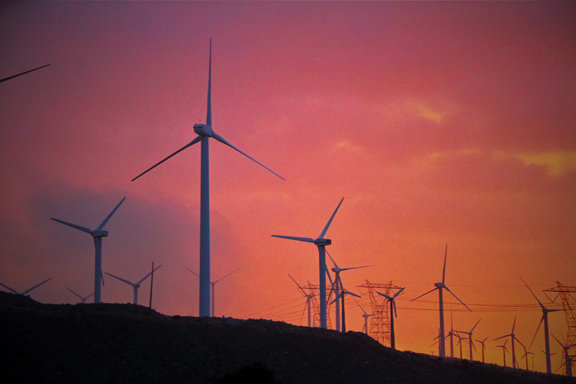
Sun and wind are two sources of renewable energy, as collected by solar panels and wind turbines, respectively.
By Charly SHELTON
Green energy is here to stay and it’s growing. Solar panels and wind farms are not a fad; they’re the most viable step to sustainable energy for the planet. According to the U.S. Energy Information Administration, “The consumption of biofuels and other non-hydroelectric renewable energy sources more than doubled from 2000 to 2017, mainly because of state and federal government requirements and incentives to use renewable energy.”
In 2017, renewable sources created about 11 quadrillion British thermal units, or BTUs, of energy, making up about 11% of the total energy consumed in the USA that year. Of that, 57% was used by the Electric Power Sector to be sent to homes, businesses and other city services that require electricity. Now the unincorporated area of Los Angeles County has the option to take part in the Green Energy movement.
Power comes to a home or business via electrical wires and poles, but where does the electricity come from? The first step in turning on a light bulb begins with the power creation, or power procurement. This is the plant where the power is created using fossil fuels or renewable resources. Then it is transmitted to a holding plant before being funneled out along power lines and into homes. This is all handled through the delivery company. In many cases, the procurement and delivery companies are the same. That is how it has been, historically, with much of the Crescenta Valley’s contract with So Cal Edison. But Assembly Bill 117, signed in 2002, states that each town has the right to choose whether it wants to buy energy from the delivery company or someone else.
Clean Power Alliance formed in 2017 “to provide cost competitive electric services, reduce electric sector greenhouse gas emissions, stimulate renewable energy development, implement distributed energy resources, promote energy efficiency and demand reduction programs, and sustain long-term rate stability for residents and businesses through local control,” according to its website. “Originally established as a joint powers authority with unincorporated Los Angeles County, Rolling Hills Estates, and South Pasadena as founding members, we quickly grew to a coalition of 31 agencies across Los Angeles and Ventura Counties.”
CPA gives consumers a choice in what sources their energy comes from: Lean Power, which provides 36% renewable energy at the lowest possible rate, Clean Power, which provides 50% renewable energy, or Green Power, providing 100% renewable energy. And as of February, So Cal Edison customers will be able to make that choice.
The unincorporated area of Los Angeles County will be switching power procurement providers in February from SCE to CPA. While the procurement company will change, the delivery company will remain SCE, meaning that the poles, wires, and even the billing will still be handled by SCE, but the energy will come from a different source.
By default, all existing SCE customers will be switched to the Clean Power plan in February with the option to change to another plan after the initial switch. If these renewable plans are not to the liking of some consumers, they may opt-out of the CPA plans altogether and remain with the SCE procurement source plan.
“SCE supports our customers’ right to purchase power from a [Community Choice Aggregation like CPA] as long as there are no costs shifted to customers who continue to purchase their power from the utility,” SCE said in a released statement. “CCAs and investor-owned utilities, such as SCE, are not in competition for customers. When CCAs enter the market, they enter the power buying and selling side of the business. The formation or growth of CCAs does not impact the number of customers SCE serves. When a CCA forms or expands, SCE continues to provide transmission and distribution service (poles, wires, transformers) and other services, such as public purpose programs, and reliability procurement for all the customers in its service area, including all CCA customers.”
The decision was made to opt-in to CPA by the LA County Board of Supervisors. Supervisor Kathryn Barger, who oversees the local district, has hope for the future relationship between unincorporated LA County and the new renewable energy provider, giving greater flexibility and choice to the residents of the area.
“The Clean Power Alliance gives residents and businesses of Los Angeles County’s unincorporated communities more choices. They can get a lower rate than what they are paying now, or they have options to use more renewable energy sources, if that is something they want to do,” said Supervisor Kathryn Barger. “There is also an option to ‘opt out’ and stay with Southern California Edison at no cost. The Clean Power Alliance is overseen by a board of Southern California elected officials, so decision makers and managers are readily accessible to consumers.”
For more info, visit CleanPowerAlliance.org.
